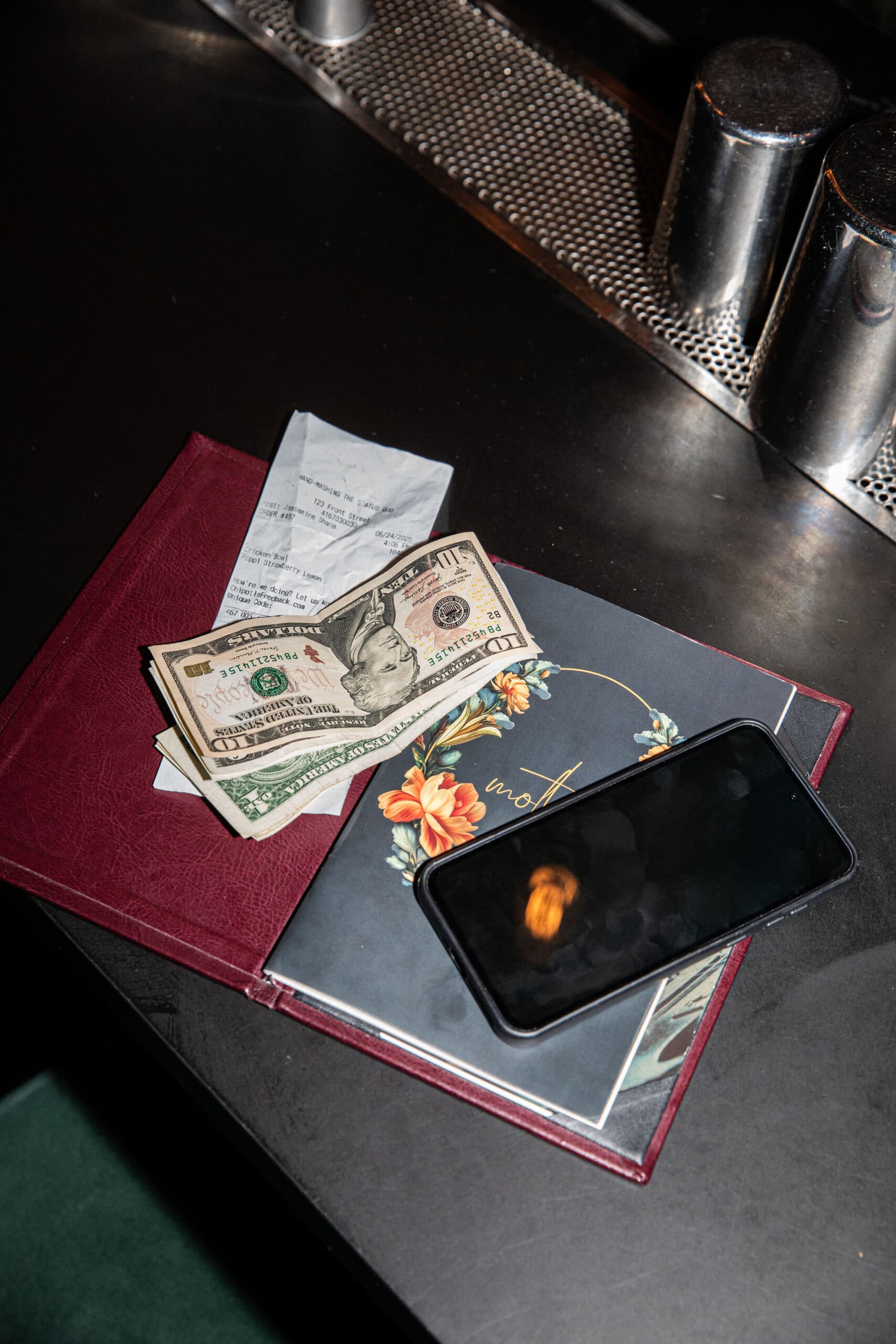Tip credits are just another part of tipping that make restaurant employee compensation complex. They are a way for tipped employees to receive at least the minimum wage they are guaranteed with acknowledgment of gratuities’ role in an employee’s earnings.
But taking an educated and careful approach to tip credits ensures that your hardworking team of waitstaff, bartenders, dishwashers, and cooks is compensated fairly (improving employee retention). For owners, it’ll ensure that you are more than prepared come tax season.
2025 Tipping Playbook
Find out how to manage your team’s tips fairly.

What is a tip credit?
Tip credits allow employers to include tips as part of wage calculation. Employers can credit a portion of an employee’s received tips towards the minimum wage obligation so that employers do not have to pay the total amount. Tip credits are not a deduction; they are simply included in the tip credit calculation.
What employers need to know about tip credits
Labor cost is typically a restaurant’s most considerable expense. Passing part of this cost directly to tipping customers allows restaurants to retain more capital. For employers, the tip credit makes it easier to keep menu prices lower, hire additional staff, enable investments in your team, and expand your business.
What employees need to know about tip credits
The tip credit ensures the full minimum wage is honored for tipped workers. Some positions don’t receive the same amount of tips. If tips do not exceed the tip credit, the restaurant must make up the difference in hourly wage for the pay period. This guarantees stability and predictability in pay for those who don’t earn a large share of tips.

How does a restaurant tip credit work?
A tip credit is a difference in money between an employee’s guaranteed wage and what obligated to pay.
Under the Fair Labor Standards Act (FLSA), employers must pay a total of the federal minimum wage ($7.25 an hour): this can be made up of the tipped minimum wage ($2.13 an hour), with the remainder ($5.12) accounted for through an employee’s tips for a combined hourly rate that equals the federal minimum wage.
According to the U.S. Department of Labor, employers must notify employees if a tip credit is being applied.

How to calculate a tip credit, if the state allows them.
What if employees don’t make enough to meet minimum wage?
Employers must make up the difference if an employee doesn’t receive enough tips to bring their total wage to the federal minimum.
Remember, these laws vary widely by state — while restaurants in some states can take much larger tip credits than $5.12, some states don’t allow tip credits.
To who do tip credits apply?
A tip credit can only be applied to the paycheck of a tipped employee. According to the Fair Labor Standards Act, a tipped employee “regularly receives more than $30 a month in tips.” While other employees may be eligible to receive tips, this is the classification for workers for whom businesses can claim a tip credit. This means those who benefit from a tip jar — like baristas and counter workers — could qualify as tipped employees, depending on their monthly earnings.
As for overtime, maximum tip credits are not impacted by overtime hours; however, minimum wage calculations are.
Consider a Texas restaurant worker pulling a 50-hour week. The minimum wage rate in Texas is $7.25 per hour, making overtime pay $10.88.
This employee earned $290 at their standard wage ($7.25 x 40 hours) plus $108.80 in overtime wages ($10.88 x 10 hours). They’re ultimately owed $398.80 at minimum for their work this week.
Assume the server earns great tips, and the restaurant can claim the full tip credit in Texas. For the regular rate of pay, the restaurant must pay $2.13 per hour for their first 40 hours worked, having claimed the $5.12 tip credit. For the normal workweek, the restaurant’s contribution to the employee’s paycheck is $85.20, with the remaining $204.80 coming from tips.
However, for overtime hours worked, the restaurant can still only claim a $5.12 tip credit, meaning the minimum cash wage for overtime hours increases at a higher percentage than regular wages.
Knowing that the employee earns a $10.88 overtime rate and that the restaurant can claim a maximum of $5.12 leaves a minimum cash wage of $5.76 ($10.88 – $5.12). Therefore, the minimum cash wage for overtime increases by $3.63, and the restaurant must provide $57.60 ($5.76 x 10 hours) in cash to the employee.
Recommended Reading: Ultimate Restaurant Payroll Guide For Owners + Operators
FICA Tip Tax Credit for Employers
In addition to tip credits, restaurants have a unique tax credit that can be applied based on employee tips: the FICA tip credit. FICA, or the Federal Insurance Contributions Act, refers to the Social Security and Medicare taxes deducted from each paycheck.
What is the FICA tip credit?
The FICA tip credit is a tax credit that food service establishments may take for the social security and Medicare taxes (FICA on the paystub) they pay for on an employee’s wages.
Put simply; it’s a tax credit that eliminates an employer’s tax contribution on tipped wages above minimum wage. And it can save restaurants a decent chunk of change.
For example, a restaurant with 15 employees making $300 in tips a week can save upwards of $10,000 a year.
Employees must keep a record of daily tips, cash, or credit card to claim this credit and provide that total to their employer annually. This also includes service charges or automatic gratuity.
Who does it apply to?
The FICA tip credit applies to employers who:
- Paid social security and Medicare taxes
- Have employees that are customarily tipped for food or beverage service
How do you calculate the FICA Tip Tax Credit?
The calculation depends on whether the employee’s current base pay is more or less than the 2007 federal minimum wage of $5.15 (the year that the credit was enacted).
If the employee’s base wage is less than $5.15 per hour:
- Hours worked x $5.15 = Minimum wage amount
- Minimum wage amount — Actual wages paid = Ineligible credit amount
- Total reported tips — Ineligible credit amount = Eligible credit amount
- Eligible credit amount x 7.65% = FICA tip credit
Example: Greta makes a base wage of $2.13 per hour. She worked 1000 hours over the year. She reports $10,000 in tips over the year.
- 1000 x $5.15 = $5150
- $5150 — $2130 = $3020
- $10,000 — $3020 = $6980
- $6980 x 7.65% = $533.97 credit


If the employee’s base wage is more than $5.15 per hour:
- Total reported tips x 7.65% = FICA tip credit
Example: Kim makes a base wage of $15.50 per hour. She reports $10,000 in tips over the year.
- $10,000 x 7.65% = $765 credit


How do you claim the FICA Tip Tax Credit?
Attach IRS form 8846 (Credit for Employer Social Security and Medicare Taxes Paid on Certain Employee Tips) to your year-end tax return.
State and local laws on tip credits
As of 2023, 43 states plus the District of Columbia and Puerto Rico allow tip credits.
Alaska, California, Minnesota, Montana, Nevada, Oregon, and Washington state prohibit tip credits, as well as the U.S. island territory of Guam.
Click the link to visit your state’s Department of Labor to learn more about your state tip pooling laws. You may also want to consult the U.S. Department of Labor (DOL) site for more information.
| States A to M | States N to W |
Recommended Reading: Tip Pooling Laws | Federal, State, FAQ and More
How to calculate tip credits: examples
The maximum tip credit your restaurant can take is always the applicable minimum wage minus minimum cash wage.
For instance, in New Jersey, the minimum wage is $13. However, the minimum cash wage restaurants must pay $5.13, leaving a maximum tip credit of $7.87.
New Jersey Tip Credit = State Minimum Wage – State Tipped Minimum Cash Wage
New Jersey Tip Credit = $13 – $5.13
New Jersey Tip Credit = $7.87
Therefore, New Jersey restaurateurs can claim a maximum tip credit of $7.87. As long as employees earn that amount in tips per hour, the restaurant will only need to compensate the worker $5.13 per hour.
But what if the minimum wage is not met?
At a restaurant in Philadelphia, Pennsylvania — where the minimum wage is also $7.25 per hour — an employee earns just $5 in average hourly tips for a 30-hour workweek, in addition to their $2.13 hourly Cash wage. This puts the server 12 cents below the $5.12 maximum tip credit—the restaurant must make up this difference.
Here’s how to calculate the additional pay owed by the restaurant.
Additional Pay = (Max. Tip Credit – Hourly Tips) x Hours Worked
Additional Pay = ($5.13 – $5) x 30
Additional Pay = $0.13 x 30 = $3.60
Here, the restaurant would be responsible for contributing $3.60 to the employee’s paycheck to ensure they meet minimum wage requirements for Pennsylvania.
Tip pooling and tip credits
So long as it’s legal in your state and minimum wage are not affected, a tip pooling arrangement can help restaurants pay out tips to their staff more equitably and include back-of-house workers as tipped employees.
As for tip pooling and the FICA tip tax credit, tip pooling could change how much you can claim.
More tip management resources
We know change can be jarring, so we’re cracking open the content vault to help you learn all about tipping best practices:
- Tip Pooling Software for Restaurants
- Tip Pooling Laws | Federal, State, FAQ and More
- [Download] Free Tip Pooling Calculator Template
- [Guide] Restaurant Tip Outs: Methods, Payouts, FAQ, and more
- Tipping Fatigue is Real: Here is How To Prevent It
Frequently Asked Questions
Do employers pay payroll taxes on tipped wages?
Because tips are part of an employee’s income, employees must pay their share of payroll taxes from these tips for Social Security and Medicare. However, as outlined above, restaurants can claim a tax credit on tips that exceed minimum wage amounts. When factoring in this credit, restaurants effectively only have to pay payroll taxes on tipped wages enough to cover the maximum tip credit for the number of hours worked.
Can employers take tips?
Employers can take tips, but according to the Department of Labor, they can only be for services that employers themselves provide. Employers cannot accept tips earned by their employees.

AJ Beltis, Author
AJ Beltis
Author
AJ Beltis is a freelance writer with almost a decade of experience in the restaurant industry. He currently works as a content manager at HubSpot, and previously as a blogger at Toast.
